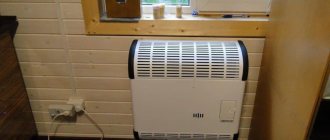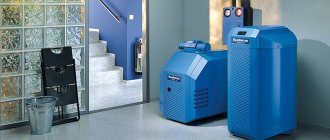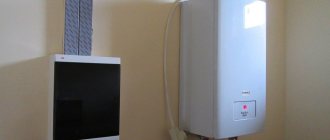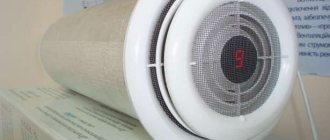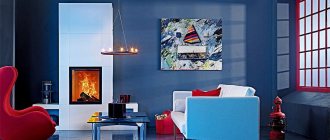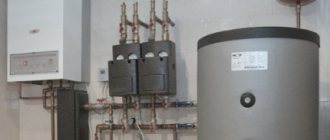Do you have your own home and want to understand how to heat it most expediently, economically and safely? Most often, to solve these problems, the option with electricity is chosen. However, choice is a complex process, so when organizing a system, you often have to consider many options. The most common of them:
- Turn out the oven. But this involves a lot of related worries (firewood, cleaning the chimney, etc.).
- Gas heating. It is environmentally friendly, convenient, there are almost no associated worries, but in order to supply gas to the house, it is necessary to make a project to supply gas to the house, which will entail large costs.
- Heating systems operating on flammable substances. It is necessary to purchase fuel and periodically clean the fires. Difficulty can also arise if you do not live in the house all the time, but only in the spring and autumn. Controlling heating in winter becomes problematic.
- There is only one thing left - heating a country house with electricity. Electric convectors are environmentally friendly, very simple and there are no associated worries. In addition, there are systems available for remote control of heaters.
Advantages of using electric convectors for heating a home
Convector heating of a house is not only the simplest, but also the most cost-effective option.
With this type of room heating, there is no need to spend money on purchasing additional equipment or paying for the work of specialists to install a complex system. The convector does not require either pipe laying or installation and adjustment of the heating boiler - you just need to attach it to the installation site using special parts. Using a convector to heat a private house, it is also possible to almost completely eliminate heat loss, which is impossible when using a heating boiler or pipes. This is achieved due to the fact that in an electric convector all heating elements are located inside the housing.
Other advantages of convectors include high efficiency, fast heating speed and fairly accurate maintenance of the set temperature in the room. Electronically controlled convectors help reduce energy consumption.
Mermen
Along with other types of heating convectors, water ones are also in demand. If we talk about the structure of this unit, we highlight the following. A water convector is a special pipe made of copper, which is equipped with aluminum fins. The entire structure is enclosed in a special casing.
They have several common features with conventional batteries, the main one of which is the coolant - in both cases, heating is carried out by heating water. The main difference is that a convector heats a room due to flows of heated air, while batteries heat it using the radiation of thermal energy from the surface of the battery itself.
How to calculate the required number of devices
As a rule, to calculate the power and number of devices required to heat a room, a formula is used based on 100 W per 1 sq.
m. For example, for a room of 15 square meters. m requires equipment with a power of 1.5 kW. It is best to install convectors under the window - 1 convector for each of them. This will allow you to heat the room with maximum efficiency. Accordingly, for a room of 15 square meters. m and three windows, it is best to purchase 3 convectors with a power of 0.5 kW each and install them under the windows to prevent the penetration of cold air into the room.
Determining the number of aluminum battery sections
It is not easy to recalculate the parameters of a heating device for specific conditions. The thermal power formula and calculation algorithm used by design engineers are too complex for ordinary homeowners who are ignorant of heating engineering.
We suggest calculating the number of sections of heating radiators using a more accessible method that gives a minimum error:
- Collect the initial data listed in the first section of this publication - find out the amount of heat required for heating, the temperature of the air and coolant.
- Calculate the actual temperature difference DT using the above formula.
- When choosing a specific type of battery, open the technical data sheet and find the heat transfer rate of 1 section at DT = 70 degrees.
- Below is a table of ready-made conversion factors for the heating power of radiator sections. Find the indicator corresponding to the real DT and multiply it by the value of the rated heat transfer - get the power of 1 fin under your operating conditions.
Knowing the real heat flow, it is not difficult to find out the number of battery fins required to heat the room. Divide the required amount of heat by the output of 1 section. For clarity, here is an example calculation:
- Let's take a corner room with two translucent structures (windows) with an area of 15.75 m², ceiling height - 280 cm (shown in a fragment of the drawing). Specific heat consumption for heating is 130 W/m², the total requirement will be 130 x 15.75 = 2048 W.
- We found out the magnitude of the thermal pressure in the previous section, DT = 43 °C.
- We select low aluminum radiators GLOBAL VOX 350 (center distance - 350 mm). According to the product documentation, the heat output of 1 fin is 145 W (DT = 70 °C).
- We find in the table the coefficient corresponding to DT = 43 °C, K = 0.53.
- We multiply the nameplate power by the coefficient and find the real output of 1 section: 0.53 x 145 = 76.85 W.
- We calculate the number of aluminum fins per room: 2048 / 76.85 ≈ 26.65, round up and get 27 pieces.
All that remains is to distribute the sections throughout the room. If the window sizes are the same, we divide 28 in half and place a radiator with 14 fins under each opening. Otherwise, the number of battery sections is selected in proportion to the width of the windows (approximately possible). The heat transfer of bimetallic and cast iron radiators is recalculated in a similar way.
Many well-known companies, including GLOBAL, indicate in the documentation the heat transfer of their devices for different temperature conditions (DT = 60 °C, DT = 50 °C), an example is shown in the table. If your real ΔT = 50 degrees, feel free to use the specified characteristics without any recalculation.
Electricity costs
It is not difficult to calculate the approximate financial costs of heating a country house with an electric convector if you know the total power of all devices (provided that more than one device is used), as well as the cost of 1 kW according to the current tariff.
It is worth considering that the convector does not work constantly - it turns off when the set temperature values are reached, and turns on again when the air temperature in the room drops. Therefore, the final amount will be significantly lower. These are, of course, approximate calculations, since the operation of the device is also influenced by many nuances that are difficult to calculate in advance.
Comparison of oil and convector heaters
If you decide to choose convector heaters, it is important to consider the pros and cons of the device even before going to the store.
Such devices differ from oil devices in the shape of the body, which is smooth and flat. Oil units, as a rule, are located on the floor, which distinguishes them from convector units. If desired, you can even install baseboard convectors, the height of which can be 15 centimeters, the length starts from 1500 cm. If you cannot decide whether to choose a convector or an oil heater, which is better of these two devices - the information presented in the article will allow you to understand
Oil units are usually located on the floor, which distinguishes them from convector units. If desired, you can even install baseboard convectors, the height of which can be 15 centimeters, the length starts from 1500 cm. If you cannot decide whether to choose a convector or an oil heater, which is better of these two devices, the information presented in the article will help you understand.
The devices can be compared with each other in terms of cost-effectiveness of use. The oil type consumes 1/4 more electricity compared to the convector type. Due to the fact that electricity tariffs are constantly rising, this factor may be decisive when purchasing a device. The warm-up period is also quite important. With the help of an oil heater this happens in several stages. First, electricity helps heat the heating element, which heats the oil, the latter transfers heat to the fins of the housing. This process can take quite a long time and consumes a certain amount of electricity. Thus, consumers note that after turning on the equipment, the room does not immediately become warm. Fans built into the oil heater can speed up this process. If we are talking about a convector, then it instantly begins to heat the air, and the efficiency is 95%. The heating rate is not so high; an oil radiator, which is equipped with a fan, outperforms a convector under additional conditions.
How to reduce costs
To keep heating costs at home lower, it is necessary to ensure minimal heat loss in the room.
Most of the heat escapes through doors, windows, attics and walls. Therefore, if the task is to reduce heat loss, first of all you should:
- Insulate windows by installing triple glazing or reducing window openings (or the number of windows). This will provide up to 10-20% heat retention.
- Insulate the doors. Or replace them with new ones with good thermal insulation.
- Insulate the attic. This will provide about 5-10% more heat.
- Insulate the walls by covering them with high-quality thermal insulation material. This gives another plus 20-30% or even 70% of heat.
How to choose a convector for a private home
When choosing electric convectors for heating a private home, first of all you should pay attention to such characteristics as the power of the equipment, the manufacturer’s brand, design, type of control and additional functions provided in the device.
The power of the equipment has already been discussed in some detail above. As for the design, the convector must be in harmony with the space surrounding it, so it is necessary to choose a model that will organically fit into the decor of the room and will not look like an alien element against the general background. Today, the market offers a huge selection of convectors of various designs and colors, as well as decorative panels for them, so choosing a model that suits the features of the interior will not be difficult.
The brand of equipment is also important - it is a guarantee of its quality and reliability. By choosing from trusted, well-proven brands, you can be sure that the equipment will last a long time and will cope with its main tasks as efficiently as possible.
If it is necessary for the convector to maintain the set temperature with extreme accuracy, you should focus on devices with electronic control - they will maintain the set parameters with an accuracy of 0.5°C. Models with mechanical control cannot boast of such high performance, and it is on them that energy consumption depends. Accordingly, by investing in an electronically controlled convector, you can count on reducing your electricity costs in the future.
Additional functions will make using the convector as comfortable as possible. These include an automatic shutdown timer, a remote control, protection against overheating and power surges, the ability to remotely control using a mobile application, etc. For country houses, the “anti-freeze” function will be useful, which will allow you to maintain a constant minimum temperature in the room from +5 to +8 °C when no one is there for a long time.
To heat a country house, it is better to choose a convector that is installed on legs on the floor, since it has greater mobility than other models.
It can be rearranged and the heating zone can be adjusted with its help.
Convector safety
The safety of home heating devices is one of the most important characteristics. For this purpose, modern models of electric convectors provide systems such as:
- Moisture protection – allows you to use convectors in rooms with high humidity without risk;
- Tip-over protection – turns off the device if it falls;
- Overheating protection – ensures automatic shutdown of the device when the set temperature values are reached, and after cooling, turns it on again.
Suitable Models
Electric convectors for home heating from the NOBO company and control of all possible electrical appliances within the facility, as well as from anywhere in the world, via SMS commands (Orion 700+GSM) or via the Internet (Energy control) is the best option.
For wooden houses, heaters of the Viking series (C2F - C4F and C2N - C4N) with a side exit of hot air into the room are more often used. The body of such convectors heats up slightly and therefore burns from contact or, moreover, fire of nearby objects is completely excluded.
In Oslo series convectors, hot air from the convector comes out upward, so it is advisable to install them under windows or on walls that border with outside air. The body of the convectors of this series, like that of Viking, does not heat up to very high temperatures, and therefore cannot cause burns or fire.
Oslo convectors have removable thermostats to regulate and maintain the air temperature in the room; there are also manually controlled thermostats or more complex ones with the possibility of remote control via the Internet or SMS commands.
Choosing an installation location
Or rather, the question is not this: which convector is suitable for fulfilling your wishes. If you want to bring the appearance of the room closer to the standard one, you can hang rectangular wall convectors under the windows. Models that can be installed under the ceiling attract a little more attention, but they are inaccessible to children and pets - they will not be able to get burned or “adjust” in their own way. The installation method is the same here - on brackets fixed to the wall. Only the shape of the brackets differs.
You can choose any location for installing the electric convector. It is only advisable that it is not covered by furniture
If you want your heating appliances not to be visible, you will have to choose between baseboard and in-floor models. There is a big difference in installation: skirting boards are simply installed and connected to the network, but for in-floor ones you will have to make special recesses in the floor - their top panel should be on the same level as the finished floor. In general, you cannot install them without major repairs.
These are floor-mounted convectors. They are also electric



